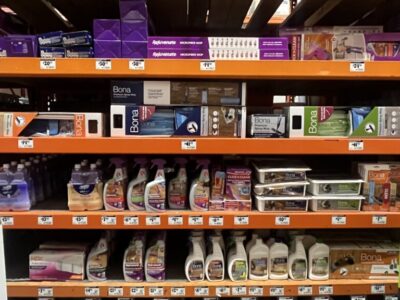How We fix wood floors
- First we evaluate your floors
- Next comes a proper cleaning
- Followed by finish restoration
- We educate and provide the proper products and maintenance requirements

Temporary shine equals later issues
silica is an adhesion killer
Waxes and polish products with silica are meant to have frequent reapplication. Below, we discuss the science of how temporary products create long term issues and higher maintenance costs. Use of silica and carnauba based floor polishes affects the ability to apply protective urethane finish coatings. Protection for your floor comes best when it has several layers of well catalyzed urethane coating between the wood surface and all foot traffic. Any contaminant that affects this combination of layers from fusing, will require sanding of your wood floors. It may be possible to remove the polish or cleaners that you have applied to your floors. The reasons for why you should avoid these products are listed below.
adhesion blockers








polish products
What the bottle doesn’t say
Silica is a molecule used to create and adjust the sheen of floor coatings. It is also something that prevents adhesion of urethane finish coatings. Polish products sometimes contain silica to provide a shiny appearance to a surface.
Aside from silica, the other common additive in floor cleaners are waxes like carnauba. Wax build up on surfaces will result in the surface becoming darker and more optically obscure over time.
All cleaners that leave trace materials on any surface will over time affect the appearance of that surface. The effects will vary depending on the type of product used and the duration. Years of using the wrong product can require very arduous restoration services to restore your floor in some cases.
The principle at play that we battle in most homes is moisture. Too much moisture on some surfaces can break them down over time. It turns out, that based on the ability to attract moisture or not, some products are actively working to attract moisture and debris. Polar versus non-polar substances.
Polarity is the characteristic that attracts or repels water to a surface. The cleaners that have a large quantity of silica will slowly attract airborne moisture to the surface of the coating. This is because of the principal of silica adsorption (think silica gel packs). The cleaners with lots of silica content have the ability to provide a great deal of shine. Unfortunately, at a microscopic level the surface is like fly paper for moisture.
Adsorption equals break down
A surface coating that endures constant moisture exposure will likely break down over time. This is especially true for coatings that do not encapsulate the silica after they are dried and cured.
The typical composition of a waterborne urethane coating includes water, de-foamer, silica, and a form of catalyzation inducer (airborne or chemical). The silica orients in a particular way during the drying process and creates sheen throughout the coating thickness. Altering the silica content of a coating alters the resulting sheen after a coating dries.
Coatings applied to a surface that contain silica and are exposed to airborne moisture eventually break down, attract debris, and dull in sheen. In addition, due to a lack of chemical catalyst the surface is very susceptible to scuffing. Anytime you drag something heavy across the polished surface, you will affect the silica orientation.

Whats up with wax
Wax-based polish products are also susceptible to break down and darkening over time. To retain an even sheen, regular product re-application is expected. Some products may even require cleaning and polishing with a maintenance buffer.
Flakes of urethane
Wax based coatings can lose adhesion to the applied surface over time. In addition, the open and breathable nature of these coatings makes airborne moisture decomposition inevitable. The layers of product over time can produce breaks in the coating and flakes of surface coating.
Darker shades ahead
The open uncatalyzed surface of some polish products will attract dander and debris with time. The picture above (with the buffer) clearly illustrates the effect of time and excessive layers of polishing products. Removal requires time and specialized tools and knowledge.
Need a floor fixed?
We have a broad network of professionals who can help. Reach out.